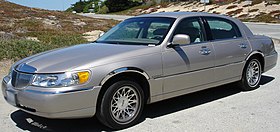| Ford Panther platform | |
|---|---|
 2000 Lincoln Town Car Signature Series | |
| Overview | |
| Manufacturer | Ford Motor Company |
| Production | 1978–2011 |
| Assembly | Canada: United States: |
| Body and chassis | |
| Class | Full-size car Full-size luxury car Personal luxury car Limousine |
| Layout | FR layout, body-on-frame |
| Body style(s) | 2-door sedan (1979–1987) 4-door sedan (1979–2012) 5-door station wagon (1979–1991) |
| Vehicles | Ford models Lincoln models Continental models |
| Powertrain | |
| Engine(s) | Ford 4.2L Small Block V8 (1981–1982) Ford 5.0L Small Block V8 (1979–1991) |
| Dimensions | |
| Wheelbase | 114.3–123.7 in (2,900–3,140 mm) |
| Chronology | |
| Predecessor | 1969 Ford |
| Successor | Ford D3 platform |
The Ford Panther platform was an automobile platform that was used by Ford Motor Company from the 1979 to 2012 model years. Following the downsizing of the General Motors B-bodies and C-bodies by two years, the Panther platform marked the end of production of sedans unencumbered by downsizing. Originally slated for discontinuation during the early 1980s, the Panther architecture was used for 33 model years, making it one of the longest-produced platforms in North American automotive history.
Developed as a successor to the 1969 Ford chassis, the rear-wheel-drive, body-on-frame Panther platform was used by the Ford and Lincoln-Mercury brands. While produced exclusively as four-door sedans from 1992 to 2012, prior to its first update, the chassis underpinned two-door sedans and five-door station wagons. Throughout its entire production life, all Panther-platform vehicles were equipped with a V8 engine; the Modular V8 engine was the first overhead-cam V8 engine used in a mass-produced American vehicle.
Initially developed in response to the implementation of CAFE by the U.S. federal government, the Panther platform outlived its closest rival (the 1977–1996 GM B platform) by 15 years, with the 2012 Ford Crown Victoria becoming the final mass-produced passenger car designed with a separate frame. While body-on-frame construction is retained by pickup trucks and larger SUVs, unibody construction (or variants thereof) see nearly universal use in passenger cars.
From 1978 to 1985, Ford and Mercury versions of the Panther platform were assembled in Hazelwood, Missouri (St. Louis Assembly). For the 1986 model year, production shifted to Talbotville, Ontario, Canada (St. Thomas Assembly). Lincoln versions were sourced from Wixom, Michigan (Wixom Assembly), until its 2007 closure; from 2008 to 2011, the Lincoln Town Car was assembled by St. Thomas Assembly. After a short production run of 2012 vehicles for export, St. Thomas Assembly produced the final Ford Crown Victoria on 15 September 2011, the final vehicle produced by the facility and the final vehicle of the Panther platform.